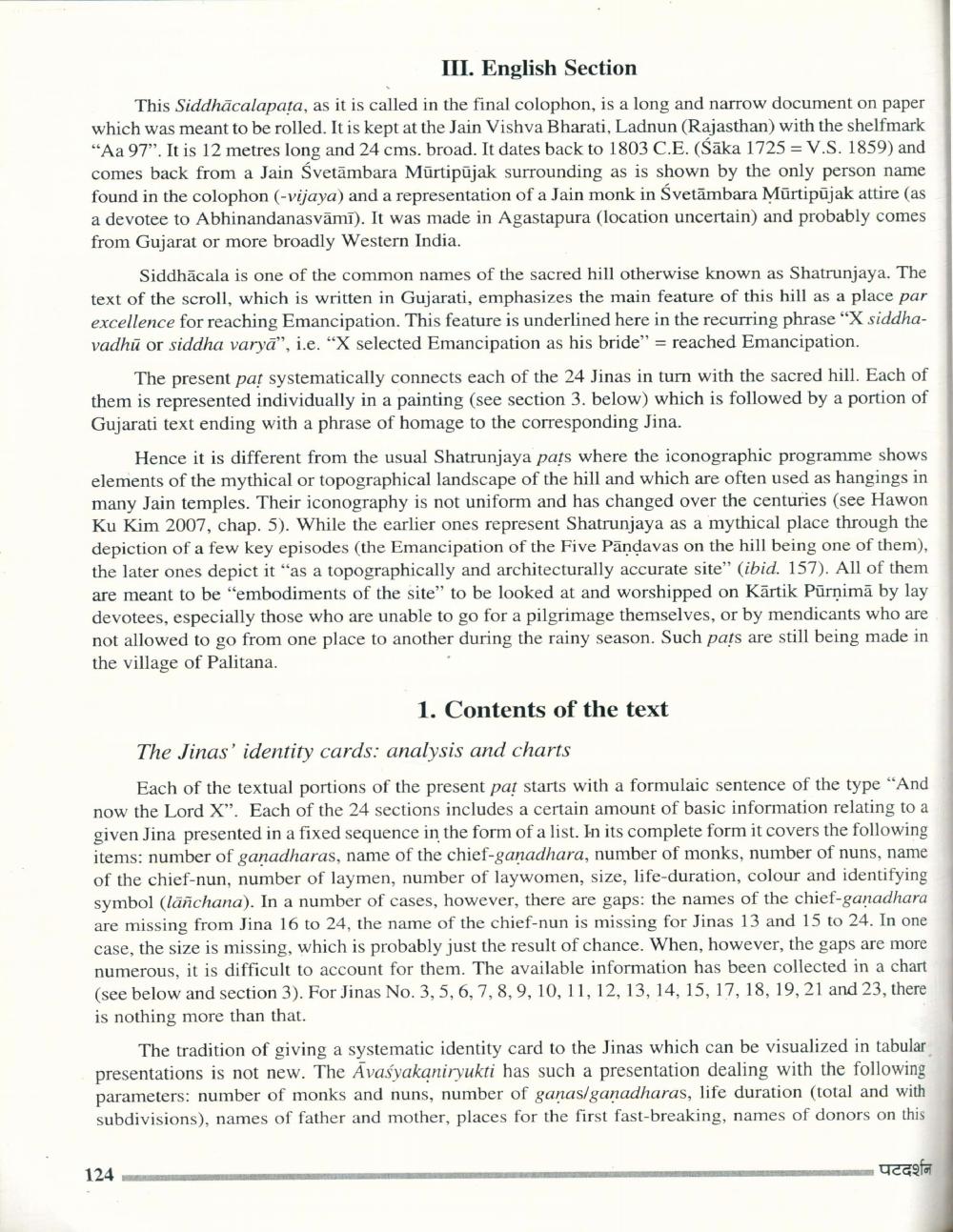________________ III. English Section This Siddhacalapata, as it is called in the final colophon, is a long and narrow document on paper which was meant to be rolled. It is kept at the Jain Vishva Bharati, Ladnun (Rajasthan) with the shelfmark "Aa 97". It is 12 metres long and 24 cms. broad. It dates back to 1803 C.E. (Saka 1725 = V.S. 1859) and comes back from a Jain Svetambara Murtipujak surrounding as is shown by the only person name found in the colophon (-vijaya) and a representation of a Jain monk in Svetambara Murtipujak attire (as a devotee to Abhinandanasvami). It was made in Agastapura (location uncertain) and probably comes from Gujarat or more broadly Western India. Siddhacala is one of the common names of the sacred hill otherwise known as Shatrunjaya. The text of the scroll, which is written in Gujarati, emphasizes the main feature of this hill as a place par excellence for reaching Emancipation. This feature is underlined here in the recurring phrase "X siddhavadhu or siddha varya", i.e. "X selected Emancipation as his bride" = reached Emancipation. The present pat systematically connects each of the 24 Jinas in turn with the sacred hill. Each of them is represented individually in a painting (see section 3. below) which is followed by a portion of Gujarati text ending with a phrase of homage to the corresponding Jina. Hence it is different from the usual Shatrunjaya pats where the iconographic programme shows elements of the mythical or topographical landscape of the hill and which are often used as hangings in many Jain temples. Their iconography is not uniform and has changed over the centuries (see Hawon Ku Kim 2007, chap. 5). While the earlier ones represent Shatrunjaya as a mythical place through the depiction of a few key episodes (the Emancipation of the Five Pandavas on the hill being one of them), the later ones depict it "as a topographically and architecturally accurate site" (ibid. 157). All of them are meant to be "embodiments of the site" to be looked at and worshipped on Kartik Purnima by lay devotees, especially those who are unable to go for a pilgrimage themselves, or by mendicants who are not allowed to go from one place to another during the rainy season. Such pats are still being made in the village of Palitana. 1. Contents of the text The Jinas' identity cards: analysis and charts Each of the textual portions of the present pat starts with a formulaic sentence of the type "And now the Lord X". Each of the 24 sections includes a certain amount of basic information relating to a given Jina presented in a fixed sequence in the form of a list. In its complete form it covers the following items: number of ganadharas, name of the chief-ganadhara, number of monks, number of nuns, name of the chief-nun, number of laymen, number of laywomen, size, life-duration, colour and identifying symbol (lanchana). In a number of cases, however, there are gaps: the names of the chief-ganadhara are missing from Jina 16 to 24, the name of the chief-nun is missing for Jinas 13 and 15 to 24. In one case, the size is missing, which is probably just the result of chance. When, however, the gaps are more numerous, it is difficult to account for them. The available information has been collected in a chart (see below and section 3). For Jinas No. 3, 5, 6, 7, 8, 9, 10, 11, 12, 13, 14, 15, 17, 18, 19, 21 and 23, there is nothing more than that. The tradition of giving a systematic identity card to the Jinas which can be visualized in tabular presentations is not new. The Avasyakaniryukti has such a presentation dealing with the following parameters: number of monks and nuns, number of ganas/ganadharas, life duration (total and with subdivisions), names of father and mother, places for the first fast-breaking, names of donors on this 124 -पटदर्शन




